Savory, soft, and flaky, with a delicious dose of caramelized and nutty browned butter, these brown butter sage dinner rolls are a flavorful upgraded version of ordinary dinner rolls. Made from 9 simple ingredients, the rolls make a wonderful aromatic and herb-infused addition to any fall, winter, or holiday meal. (Try them with pumpkin chili!) See recipe Notes for make-ahead instructions.
This recipe is brought to you in partnership with Red Star Yeast.
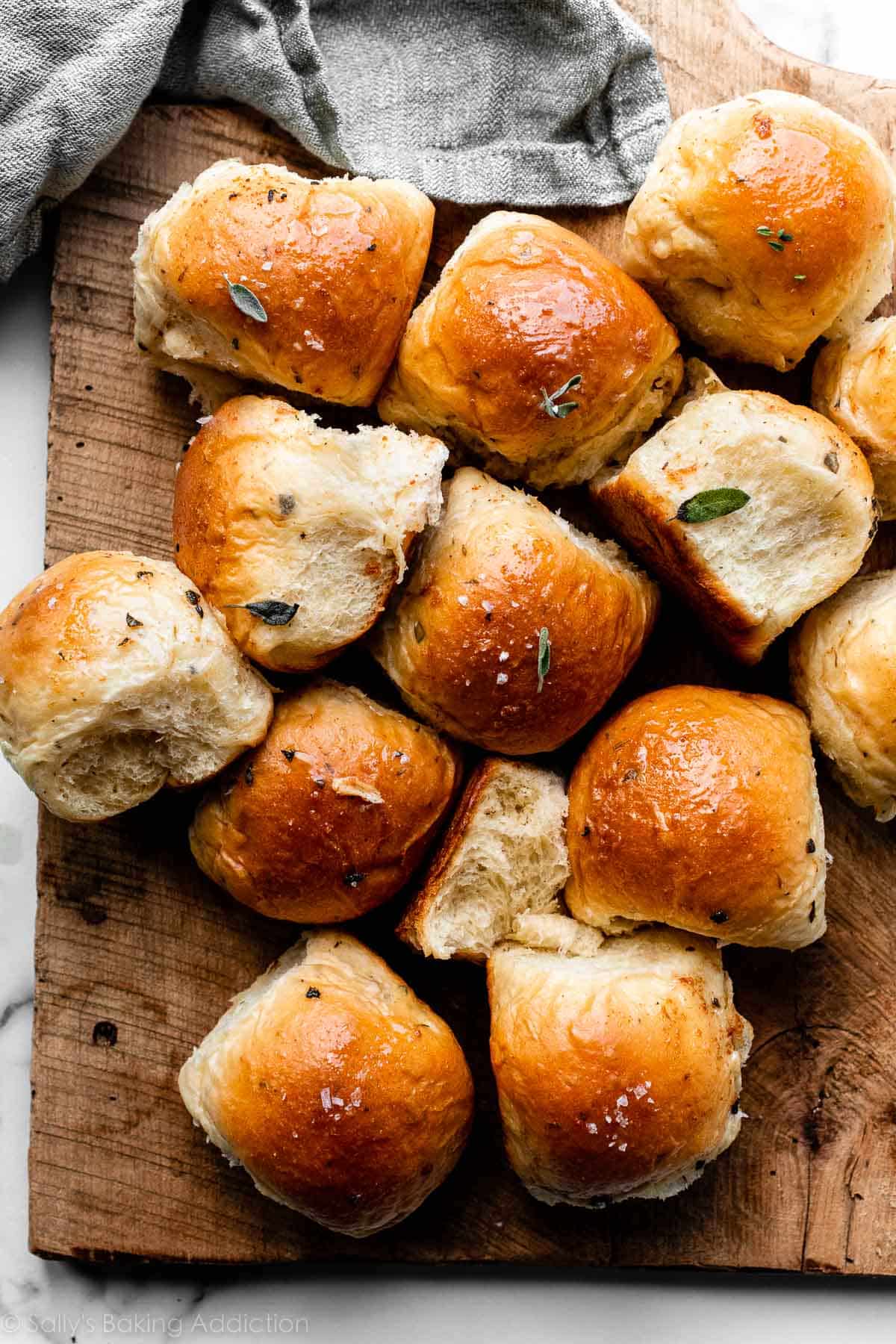
I figured out what side dish should be on every dinner table from now until March. Basically, if it’s sweater weather, we should all be baking these brown butter sage dinner rolls. 😉
More than a side dish, these savory rolls are like a side of comfort for your comfort food!
Here’s Why You’ll Love These Sage Dinner Rolls
- 9 simple ingredients
- Browned butter adds depth of flavor, without adding too much prep time
- Rolls are super soft, buttery, & flaky
- Delicious earthy herb flavors from fresh sage & thyme; feel free to switch up the herbs
- Adjust prep time to your schedule—make-ahead options detailed in Notes below
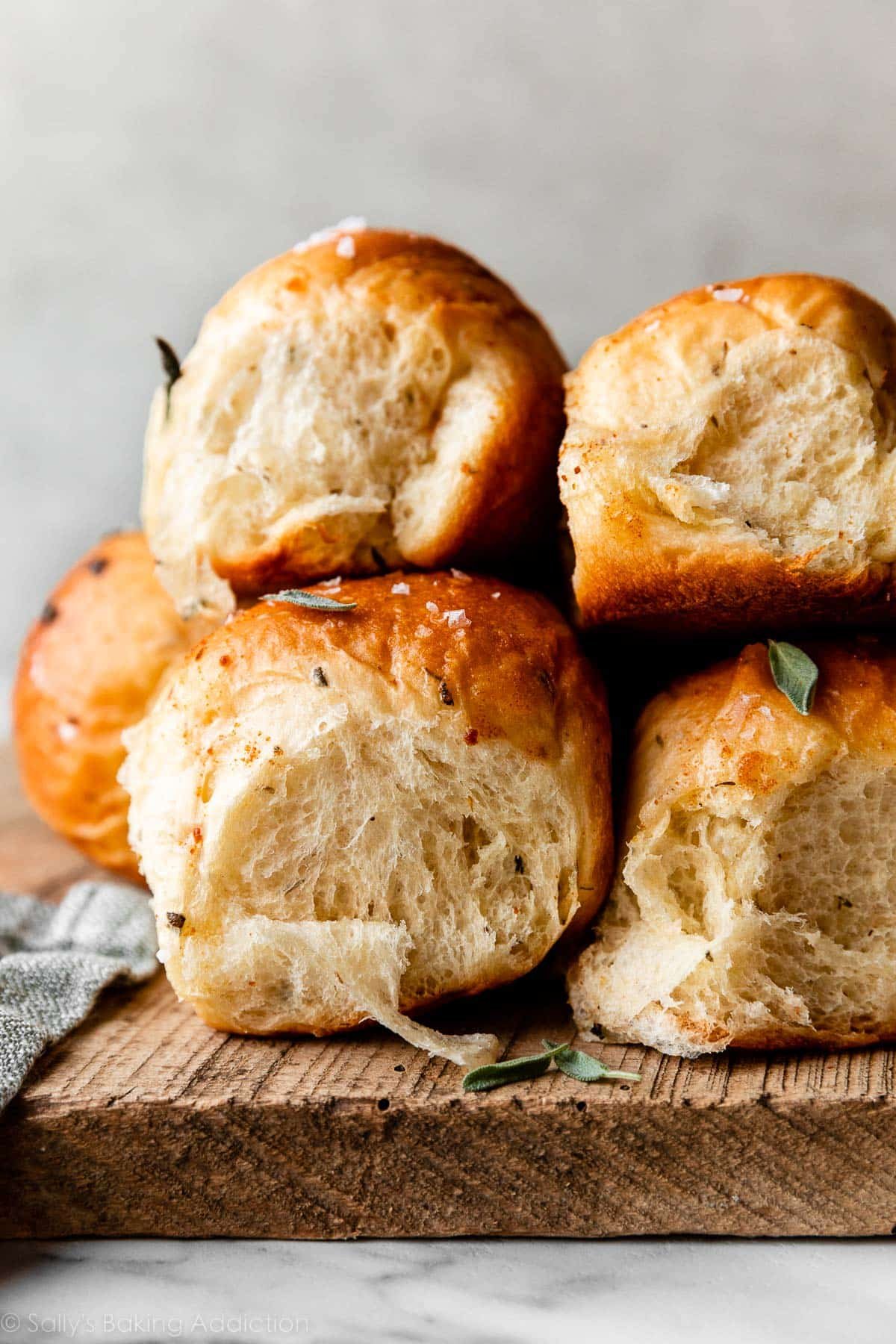
Key Steps in This Recipe
- Browning the butter: Browning butter gives a depth of flavor to an already delicious key ingredient. See How to Brown Butter if you’ve never done it before. (It’s easy!)
- Proofing the yeast: Proofing the yeast isn’t always necessary when you use instant yeast. However, I recommend doing it anyway to ensure the yeast dissolves and that it’s alive and active. Mix the yeast with warm buttermilk (or regular milk) and a little honey. Cover and let it sit for 5 minutes until foamy on top. Are you a bread-baking beginner? Reference my Baking with Yeast Guide for answers to common yeast FAQs.
- Making the dough: The dough comes together with milk, yeast, honey, egg, brown butter, salt, fresh sage and thyme, and flour. The honey feeds the yeast and tenderizes the dough. You can use all-purpose flour or bread flour in this recipe. You can use a stand mixer or a spatula to combine the dough ingredients.
- Kneading the dough: Knead the dough with your hands (or a stand mixer fitted with a dough hook) for 3 minutes.
- 1st rise: The dough rises in about 1.5-2 hours in a relatively warm environment.
- Shaping the rolls: Form the rolls into balls as if you were making regular dinner rolls.
- 2nd rise: Let the shaped rolls rise until puffy, which takes up to 1 hour.
- Baking: Bake until the rolls are golden brown, around 25 minutes.
- Finishing: Brush remaining brown butter, mixed with a little bit more chopped sage, on the warm rolls, and sprinkle some sea salt on top, if desired.
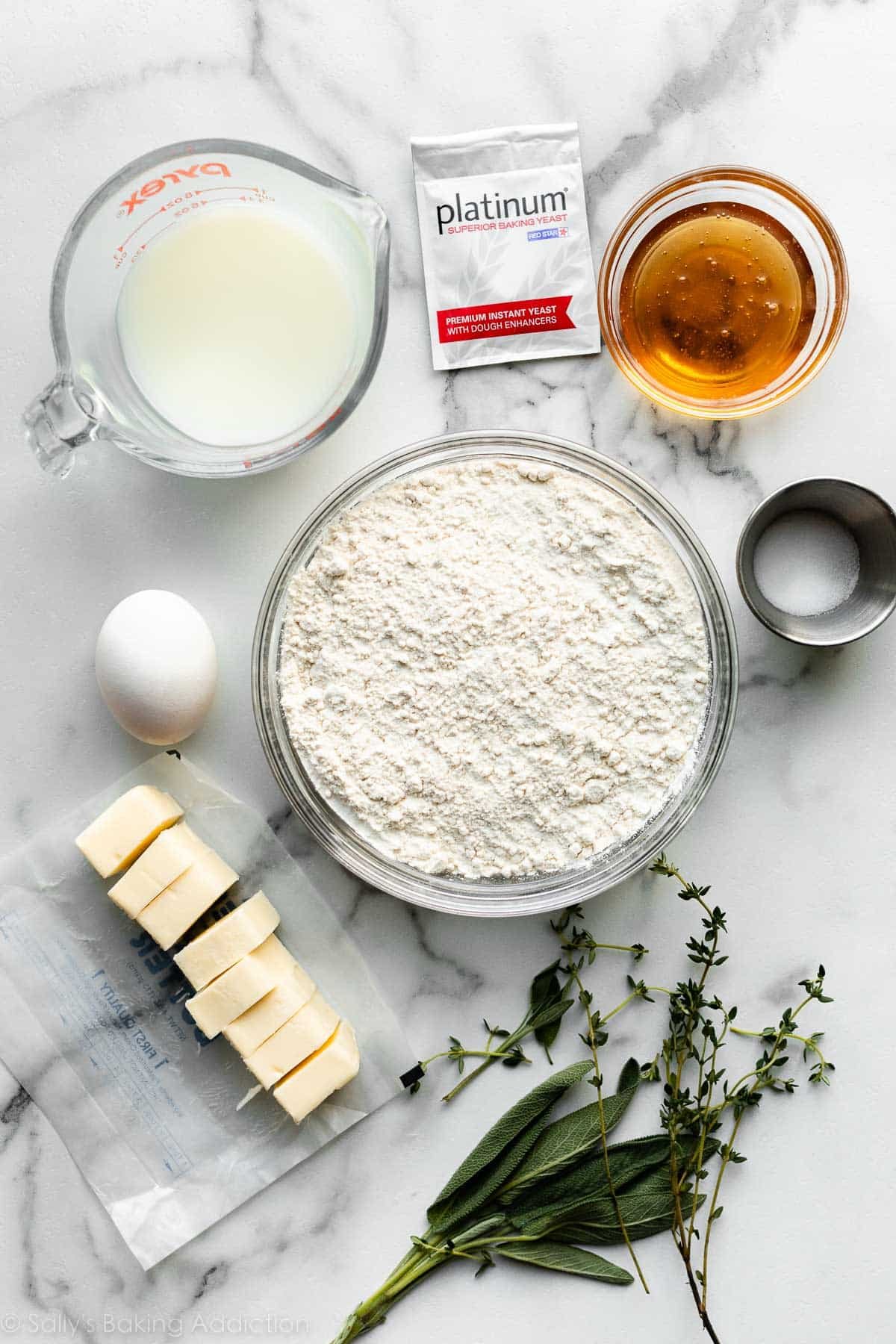
Brown the butter on the stovetop first. You’ll use 6 Tablespoons of brown butter in the bread dough and reserve whatever you have left for brushing on top of the warm rolls.
All of the browned bits at the bottom of the pan hold so much flavor; do not omit!
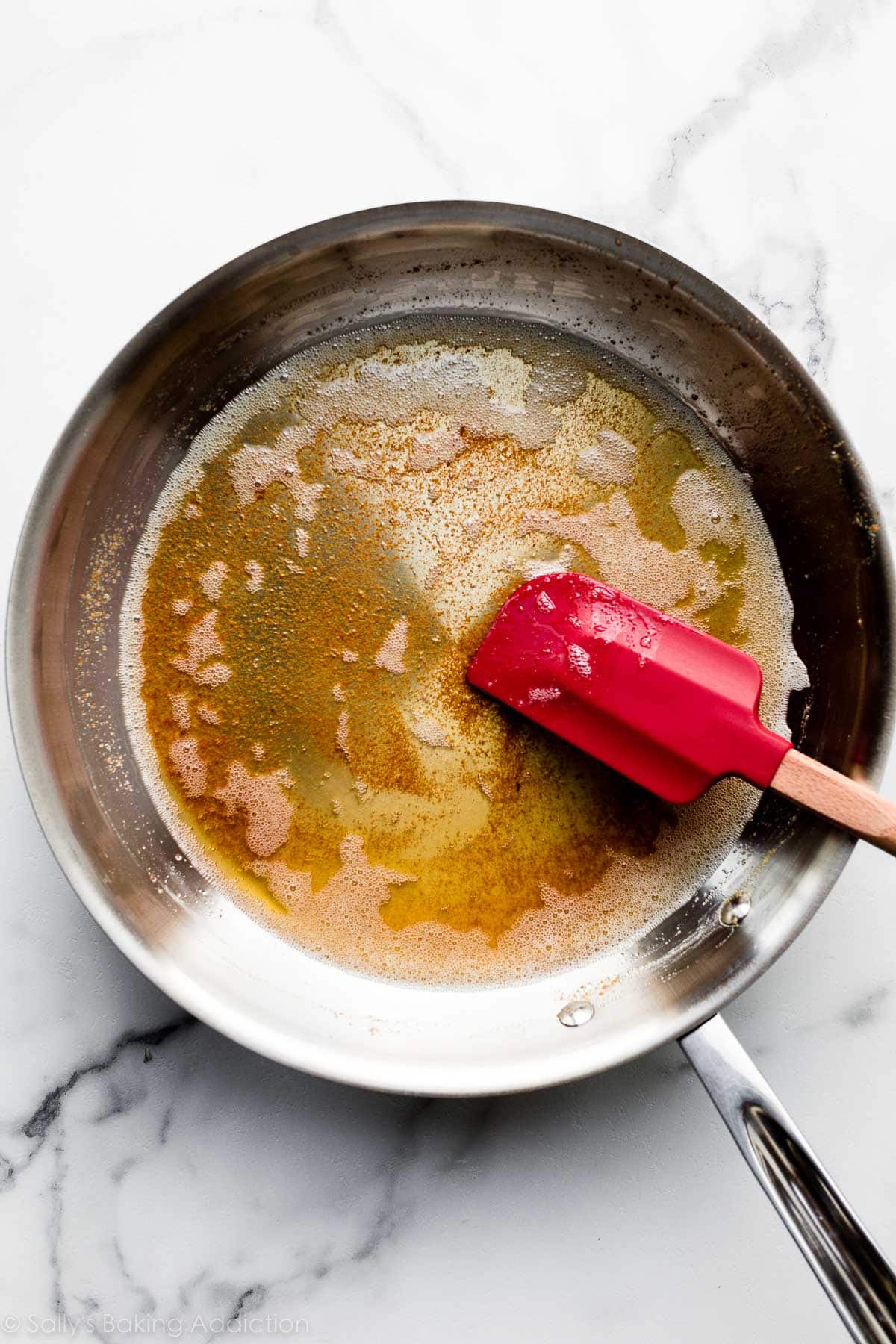
Sage Dinner Rolls Require a Rich Dough
The crustier and chewier the bread, the less fat in the dough. The softer and richer the bread, the more fat in the dough. Unlike bagels, focaccia, and homemade artisan bread, buttery-soft sage rolls require a rich dough. “Rich” correlates with the amount of fat. For example, this dough has milk, brown butter, and egg.
- Which yeast do I use? You can use active dry yeast or instant yeast in this recipe. If using active dry yeast, the rise times will be a little longer. I recommend Platinum Yeast from Red Star, which is an instant yeast blended with natural dough improvers.
Combine the yeast with warmed milk, a little honey, and your yeast. Let this mixture sit for 5 minutes or until foamy on top (pictured below, left). Then, add the rest of the ingredients to form a soft dough (pictured below, right).
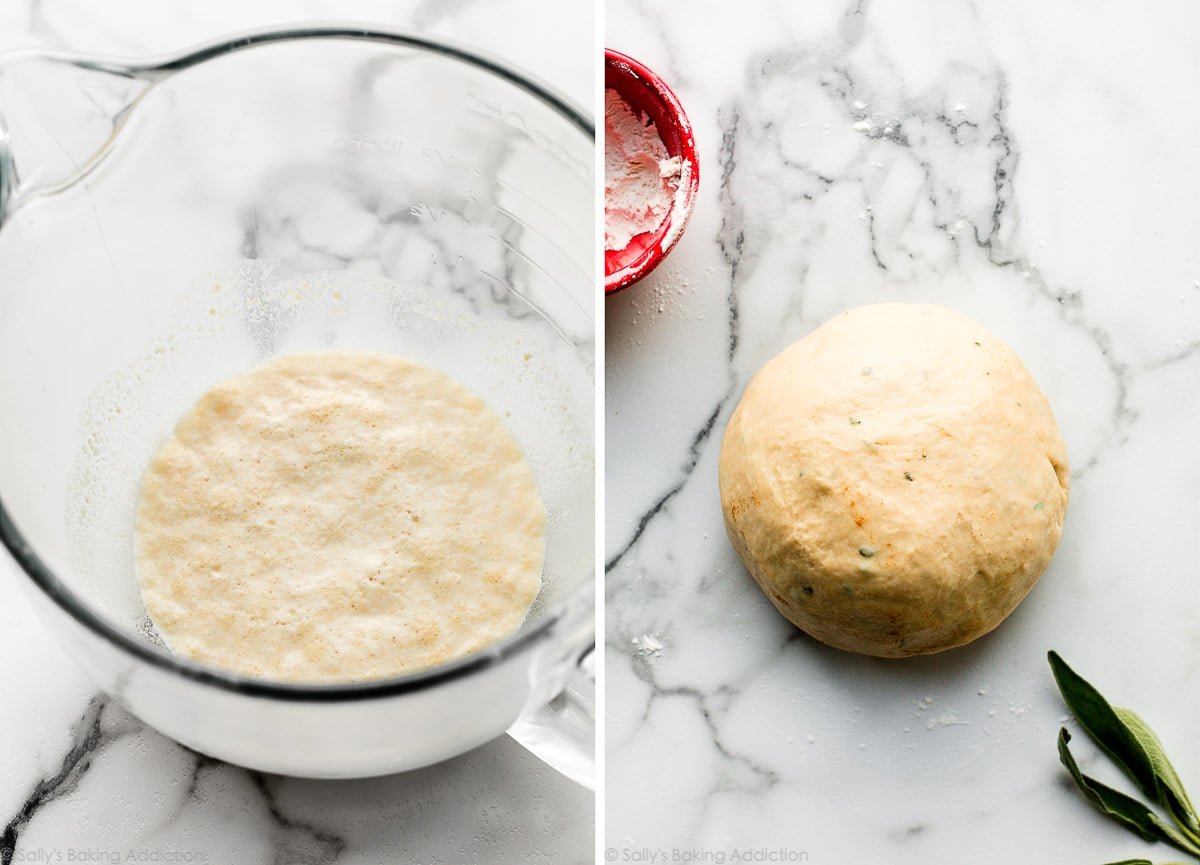
Let the dough rise until double in size and then punch it down to release the air:
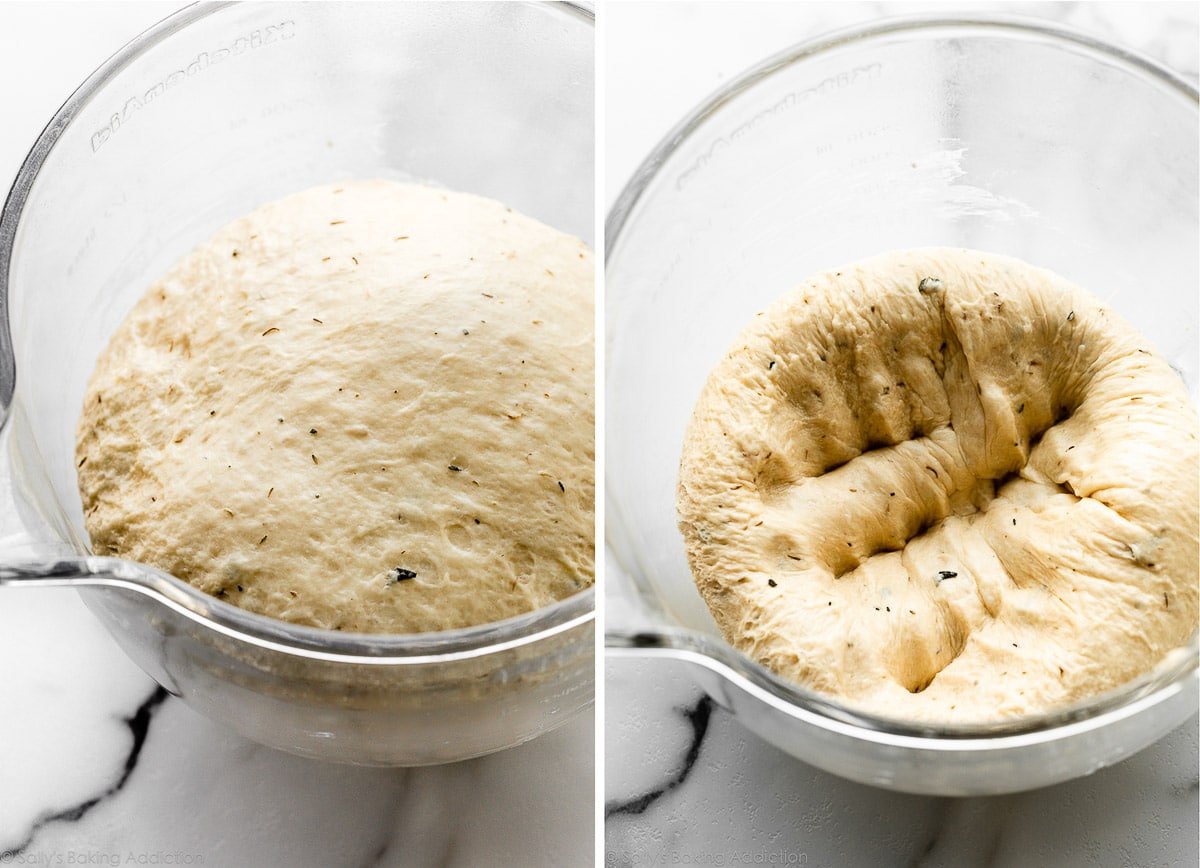
After that, shape into 14-16 balls and arrange in a baking pan. Don’t worry if they’re not all uniform in size. A 9×13-inch pan is ideal for these brown butter sage dinner rolls, but you can bake them on a lined baking sheet or in 2 9-inch round or square pans instead.
Let the shaped rolls rise before baking. Look how puffy they get after 1 hour of rising:
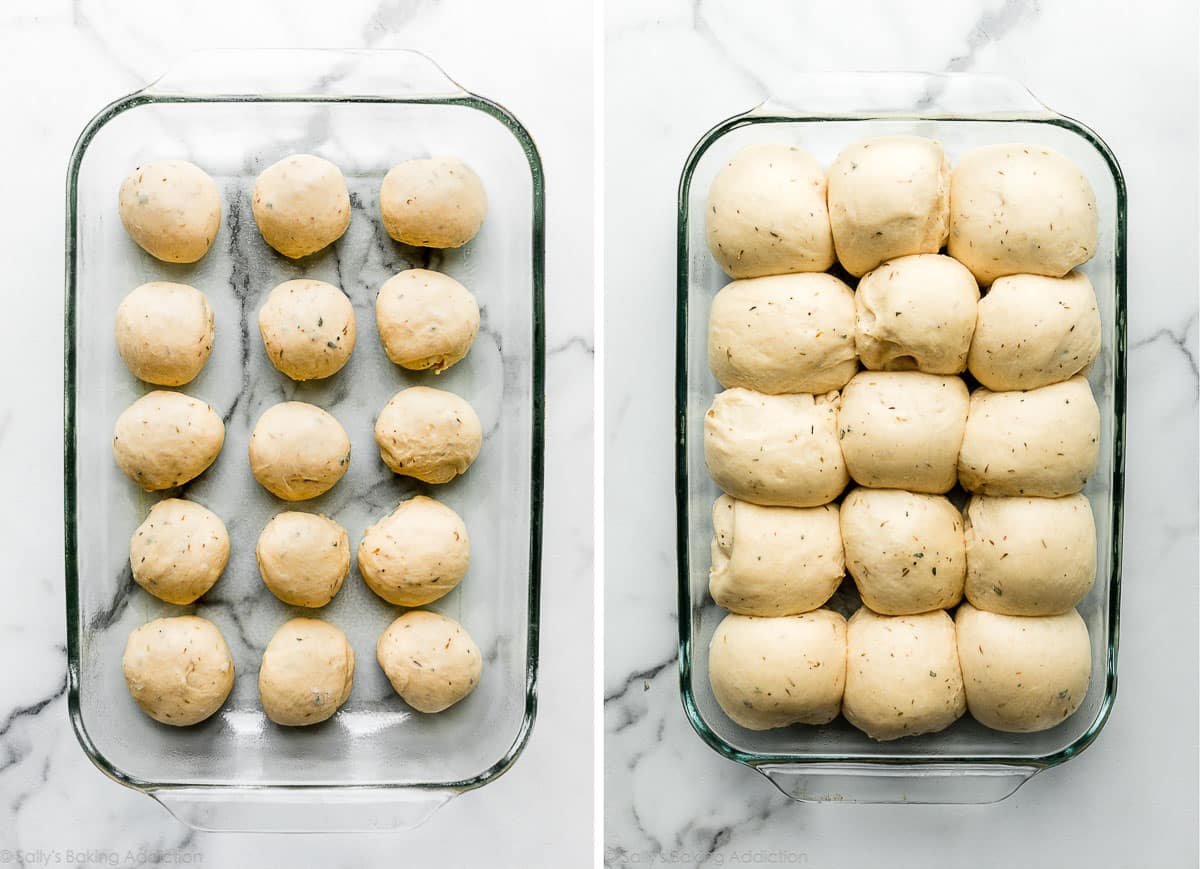
Finish With Herbed Brown Butter & Sea Salt
The rolls are done when they’re golden brown… and just wait until you smell these baking!
Brush the warm rolls with the remaining brown butter, mixed with a little more chopped sage, and finish with an optional sprinkle of sea salt. If you’re ever shopping online for sea salt and need a recommendation, I use and love Maldon sea salt.
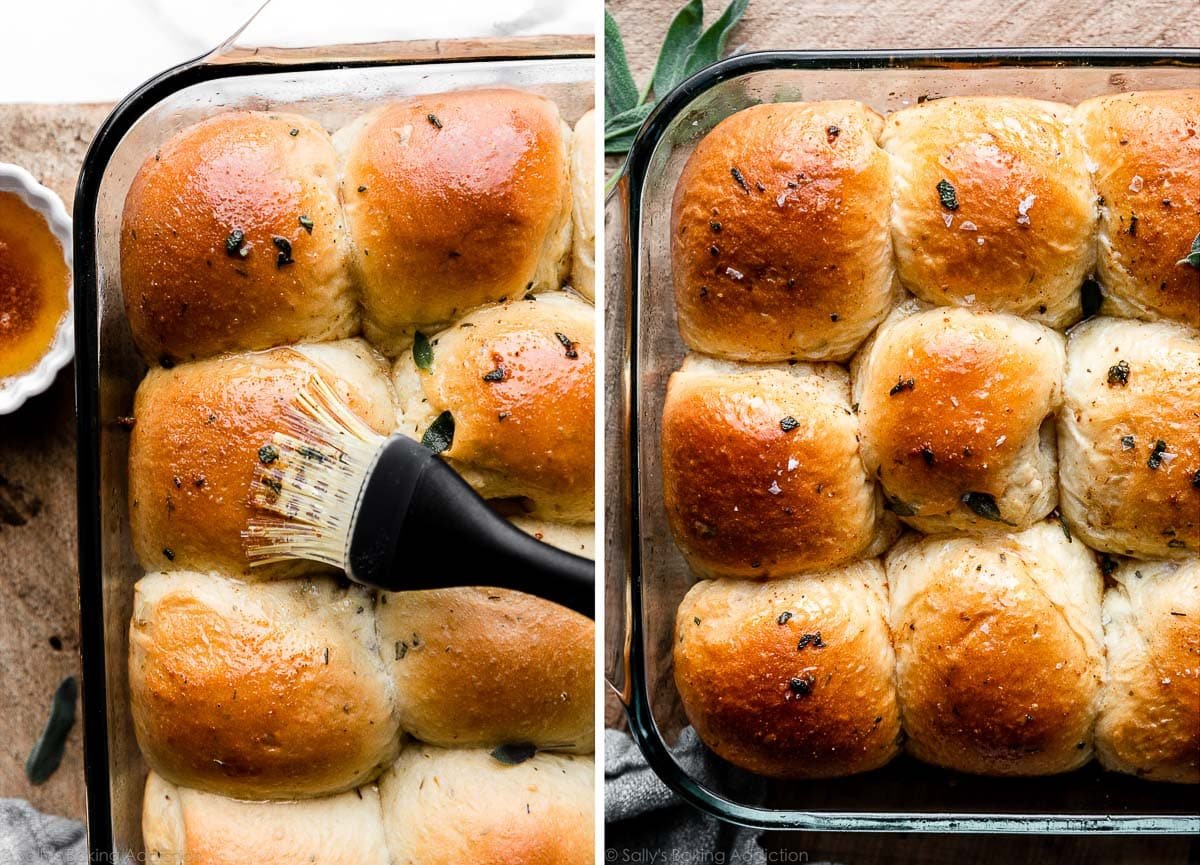
What About Other Flavors?
Thyme & sage work hand-in-hand to produce a deep herb flavor in today’s rolls. If you want to switch it up, substitute rosemary or parsley for one or both or try these garlicky herb skillet rolls instead. I have even more dinner rolls options if you’re looking for inspiration:
- Plain Dinner Rolls
- 100% Whole Wheat Dinner Rolls
- Hot Cross Buns
- Soft Pretzel Rolls
- Homemade Bread Bowls
Can I Turn This Into a Loaf of Bread?
No, I don’t recommend using today’s dough recipe for a loaf of bread because it’s not sturdy enough. Instead, try cranberry nut bread, olive bread, rosemary pull apart bread, or this sandwich bread.
Today’s soft dough is best shaped into rolls.
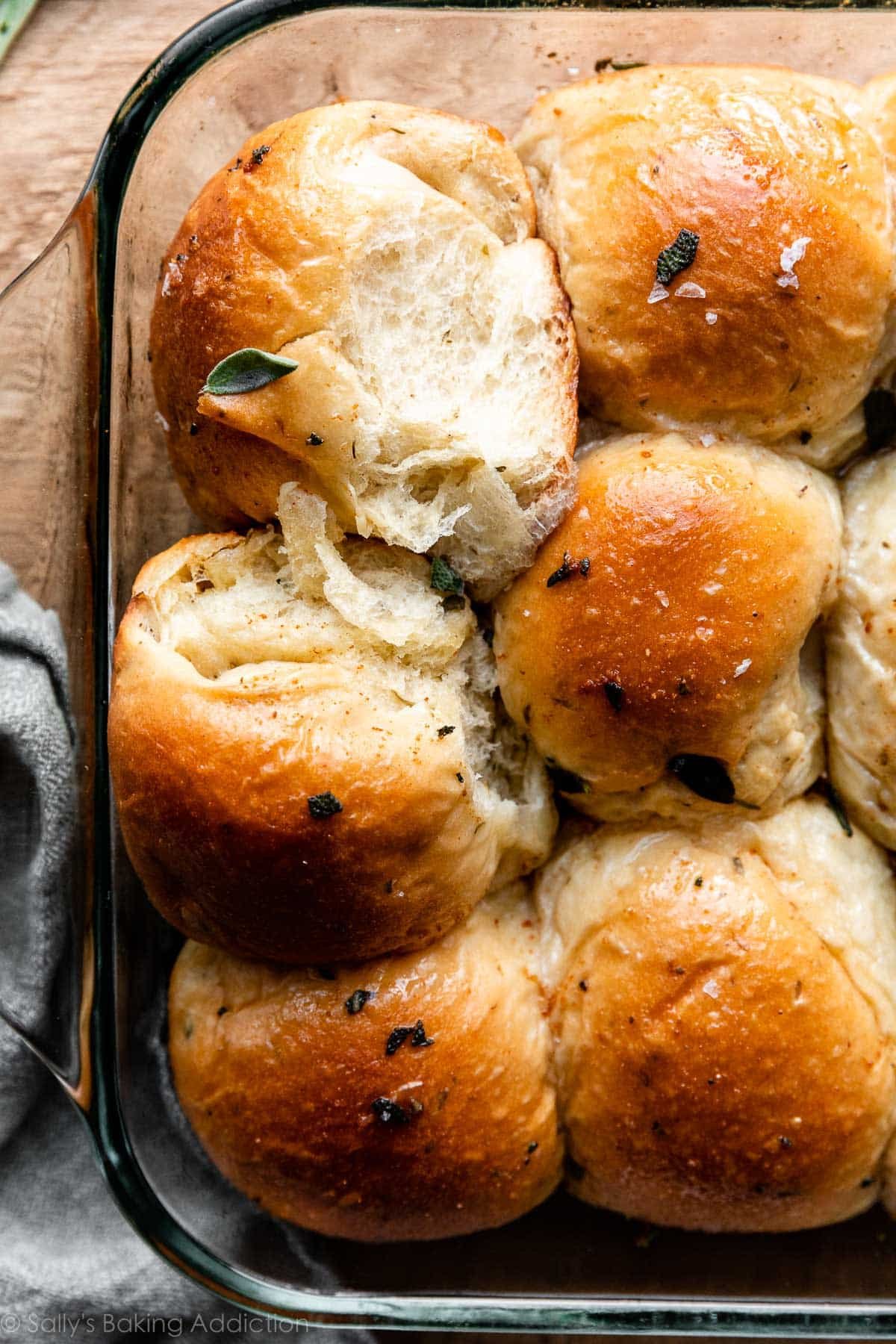
Serve brown butter sage rolls with cold weather favorites like your Thanksgiving dinner, creamy chicken noodle soup, lemon thyme chicken, sausage stuffed peppers, or minestrone soup.
Description
Savory, soft, and aromatic, with a delicious dose of the caramelized nutty flavor that comes from browning butter, these flavorful rolls make a wonderful addition to any fall, winter, or holiday dinner. See recipe Notes for make-ahead instructions.
- Brown the butter: Set out a medium heatproof bowl because you’ll need it at the end of this step. Place the sliced butter in a light-colored skillet or saucepan. A light-colored interior is crucial for determining when the butter begins to brown. (See Notes if using a dark skillet or pan.) Melt the butter over medium heat and stir or whisk constantly. Once melted, the butter will begin to foam. Continue stirring/whisking, keeping a close eye on it. After about 5–7 minutes, the butter will begin browning and you’ll notice lightly browned specks forming at the bottom of the pan. The butter will have a nutty aroma. The color will gradually deepen, from yellow to golden to golden-brown; once it’s a light caramel-brown color, remove from heat immediately and pour into the bowl, including any brown solids that have formed on the bottom of the pan. Cool for 10 minutes.
- Prepare the dough: Whisk the warm milk, yeast, and 1 Tablespoon honey together in the bowl of your stand mixer. Or, if you do not own a stand mixer, a regular large mixing bowl. Loosely cover and allow to sit for 5—10 minutes until foamy and frothy on top.
- Add the remaining honey, the egg, 6 Tablespoons (90ml) of the slightly cooled brown butter (reserve the rest for brushing on top of rolls in step 11), the salt, sage, thyme, and 1 cup bread flour. With a dough hook or paddle attachment, mix/beat on low speed for 30 seconds, scrape down the sides of the bowl with a rubber spatula, then add the remaining bread flour. Beat on medium speed until the dough comes together and pulls away from the sides of the bowl, about 2 minutes. If the dough seems too wet to a point where kneading (next step) would be impossible, beat in more flour 1 Tablespoon at a time until you have a workable dough. Dough should be soft and a little sticky, but still manageable to knead with lightly floured hands.
- Knead the dough: Keep the dough in the mixer and beat for an additional 3 full minutes or knead by hand on a lightly floured surface for 3 full minutes.
- 1st Rise: Lightly grease a large bowl with oil or nonstick spray. Place the dough in the bowl, turning it to coat all sides in the oil. Cover the bowl with aluminum foil, plastic wrap, or a clean kitchen towel. Allow the dough to rise in a relatively warm environment for 1.5-2 hours or until double in size. (I always let it rise on the counter. Takes about 2 hours. For a tiny reduction in rise time, see my answer to Where Should Dough Rise? in my Baking with Yeast Guide.)
- Grease a 9×13 inch baking pan or two 9-inch square or round baking pans. You can also bake the rolls in a cast iron skillet or on a lined or greased baking sheet. (See recipe Note.)
- Shape the rolls: When the dough is ready, punch it down to release the air. Divide the dough into 14-16 equal pieces. (Just eyeball it– doesn’t need to be perfect!) Shape each piece into a smooth ball. Arrange in prepared baking pan or a couple inches apart on a lined baking sheet.
- 2nd Rise: Cover shaped rolls with aluminum foil, plastic wrap, or a clean kitchen towel. Allow to rise until puffy, about 45-60 minutes.
- Adjust oven rack to a lower position and preheat oven to 350°F (177°C). (It’s best to bake the rolls towards the bottom of the oven so the tops don’t burn.)
- Bake the rolls: Bake for 23-27 minutes or until golden brown on top, rotating the pan halfway through. If you notice the tops browning too quickly, loosely tent the pan with aluminum foil.
- Remove rolls from the oven. Heat remaining browned butter to melt it since it has likely solidified (you can do this in the microwave for 10-20 seconds) and mix with a pinch of fresh chopped sage. Brush mixture all over warm rolls. If desired, sprinkle tops with coarse sea salt. Cool for a few minutes before serving.
- Cover leftover rolls tightly and store at room temperature for 2-3 days or in the refrigerator for up to 1 week.
Notes
- Freezing Instructions: Prepare recipe through step 7. Place shaped rolls in a greased baking pan, cover tightly, and freeze for up to 3 months. Once frozen, the dough balls won’t stick together anymore and you can place them in a freezer bag if needed. On the day you serve them, arrange the dough balls in a greased baking pan, cover tightly, then let them thaw and rise for about 4–5 hours. Bake as directed. You can also freeze the baked dinner rolls. Allow them to cool completely, and then freeze for up to 3 months. Thaw in the refrigerator or at room temperature, then reheat as desired. If reheating the whole pan, lightly cover and reheat in a 300°F (150°C) oven for about 10 minutes or until warm.
- Overnight Instructions: Prepare the recipe through step 7. Cover the shaped rolls tightly and refrigerate for up to about 15 hours. At least 3 hours before you need them the next day, remove the rolls from the refrigerator, keep covered, and allow to rise on the counter for about 1–2 hours before baking. Alternatively, you can let the dough have its 1st rise in the refrigerator overnight. Cover the dough tightly and place in the refrigerator for up to about 15 hours. Remove from the refrigerator and allow the dough to fully rise for 2 more hours. Continue with step 9.
- Special Tools: Stand Mixer | 9×13 Glass Baking Pan | Pastry Brush
- No Stand Mixer? If you do not own a stand mixer, you can use a large mixing bowl and mix the dough together with a sturdy rubber spatula or wooden spoon. It will take a bit of arm muscle. A hand mixer works, but the sticky dough repeatedly gets stuck in the beaters. Mixing by hand with a wooden spoon or rubber spatula is a better choice.
- Baking Pan: I prefer baking the rolls in a glass 9×13 inch baking pan because I find they brown a little too quickly in a metal pan. But as long as you bake the rolls on a lower oven rack and keep your eye on them, any pan is great. You can also bake these rolls in a large cast iron skillet, or two 9-inch round or square baking pans. Bake time remains the same.
- Milk: Buttermilk or whole milk are ideal for best, richest flavor and texture. Keeping that in mind, feel free to substitute with a lower fat or nondairy milk.
- Yeast: Platinum Yeast from Red Star is an instant yeast. You can use Red Star Yeast active dry yeast instead. Rise times will be slightly longer using active dry yeast. Reference my Baking with Yeast Guide for answers to common yeast FAQs.
- Herbs: If you don’t have fresh herbs, you can use dried instead. Simply reduce the amount by half, so 1 teaspoon dried sage and 1/2 teaspoon dried thyme. (Add more if you want extra flavor.)
- Flour: If you don’t have bread flour, you can use all-purpose flour. All-purpose flour is convenient for most, but bread flour produces chewier dinner rolls. The rolls are still soft and fluffy no matter which you use. Either flour is fine and there are no other changes to the recipe if you use one or the other.
Keywords: brown butter sage dinner rolls
Subscribe
Baking Made Easy
Are you new to this website? This email series is a great place to start. I’ll walk you through a few of my most popular recipes and show you exactly why they work.
